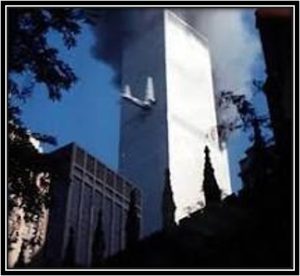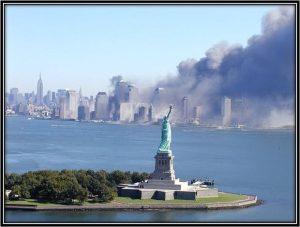This Week in Aviation History-9-11
Contributor: Barry Fetzer
Sources: Microsoft Copilot AI, Reuters, American Legion, National September 11th Memorial and Museum
The 24th anniversary of 9-11 came and went this past Thursday and it’s worth the time and effort to review it one more time, this time from a mostly aviation perspective with no intent to, thereby, diminish the horrific loss of life in both the aircraft and on the ground on September 11, 2001.
According to AI (Microsoft’s “Copilot”), “Nineteen al-Qaeda terrorists hijacked four flights originating from East Coast airports and bound for California. Large, fuel-heavy, transcontinental flights were chosen to maximize the destructive power of the attacks.”

The second tower of the World Trade Center bursts into flames after being hit by a hijacked airplane in New York City, September 11, 2001. REUTERS/Sara K. Schwittek
“American Airlines Flight 11 was a Boeing 767 that departed from Boston’s Logan International Airport. It crashed into the North Tower of the World Trade Center at 8:46am (as seen in the right tower in the above photo).
United Airlines Flight 175 was a Boeing 767 that also departed from Boston’s Logan International Airport. It was flown into the South Tower of the World Trade Center at 9:03am (as seen at just after the time of impact in the left tower in the above photo.)
American Airlines Flight 77 was a Boeing 757 that departed from Washington Dulles International Airport. At 9:37 a.m., it crashed into the Pentagon, the headquarters of the U.S. Department of Defense.
United Airlines Flight 93 was a Boeing 757 that departed from Newark International Airport. After passengers fought back against the hijackers, the plane crashed into a field in Shanksville, Pennsylvania, at 10:03am.”

Flight 175 at the moment of impact on the South Tower. Note North Tower burning behind. Courtesy National September 11th Memorial.
Immediate aviation response
“Following the strikes, air traffic control and military personnel coordinated an unprecedented and historic response.
Ground stop order: Ben Sliney, the Federal Aviation Administration’s (FAA) national operations manager, issued a nationwide “ground stop” order at 9:42 a.m. on his first day on the job. This was the first time in U.S. aviation history that all airborne flights were required to land immediately.”
“Emptying the skies: Within four hours of the order, air traffic controllers successfully and safely guided more than 4,500 commercial and private flights to the nearest airports. By 12:15 p.m., the U.S. airspace was completely empty of all commercial and private flights.”
“Military alert: President Bush authorized any non-compliant aircraft to be shot down. Fighter jets from the North American Aerospace Defense Command (NORAD) were scrambled to intercept suspected aircraft, though none reached their targets in time.”

Courtesy American Legion.
“Rapid Response: This unprecedented order was carried out with incredible speed, with over 4,500 planes landed within the first three hours of the shutdown.
International Diversions: Incoming international flights to the U.S. were diverted to Canadian airports as part of Operation Yellow Ribbon, which was the name given to the Canadian initiative to accommodate the grounded planes.”
Significance
“First-Ever Unplanned Shutdown: The closure of U.S. airspace was the first and only unplanned closure of its kind in history. Massive Feat: The coordinated effort to land thousands of planes in such a short amount of time is considered a remarkable achievement in air traffic control history.”
“Commercial flights in the U.S. resumed on September 13, 2001, two days after the 9/11 attacks, with new, stricter security measures in place. Airspace was gradually reopened with new security standards, and different airports and classes of aviation (like foreign carriers or general aviation) were authorized to resume operations on different schedules over the following days, with Washington’s Reagan National Airport remaining closed until October 4.”
Postscript: On September 12, 2001, still on active duty in the Marines on the staff of MCAS Cherry Point, NC at the time, I was stranded at McConnell AFB in Wichita, Kansas by the ground stop ordered for nearly every aircraft in America. Yet, an MCAS New River, NC C-12 (a militarized twin-engine Beech King Air) at McConnell AFB was permitted to file an instrument flight plan to return to MCAS New River. Once I was informed that C-12 was at McConnell AFB (thanks to my wife), I rushed from my hotel room to the Air Force Base to board that “turning and burning” C-12 and take off before someone in charge figured out what was going on and instructed the C-12 pilot (a friend of mine whose wife had called my wife) to shut down and deny his taxi and take off.
It pays to have “people in high places” (our wives included, in this case😊), I guess.
Somehow, we were permitted to taxi and take off and fly across two thirds of the US direct to MCAS New River. None of us involved in that unlikely flight know exactly why we were permitted to take off and fly during the 9-11 ground stop, less than 30 hours after United Flight 93 crashed in Shanksville, PA. The bored FAA controllers all the way home mentioned that we were one of only a dozen or fewer aircraft airborne over the entire continental US, all military aircraft.
Onward and upward!
Sources: Microsoft Copilot AI, Reuters, American Legion, National September 11th Memorial and Museum







